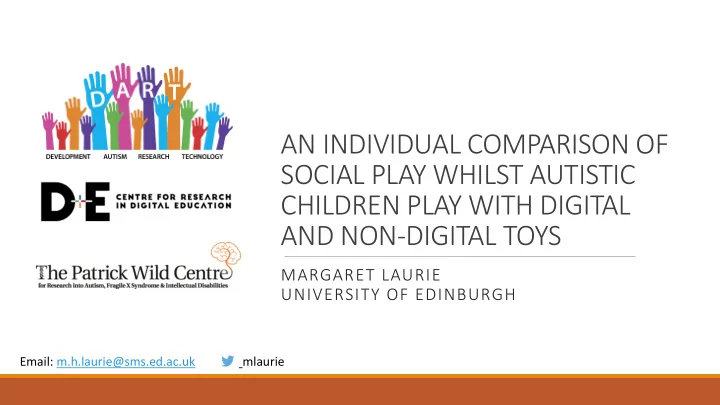

AN INDIVIDUAL COMPARISON OF SOCIAL PLAY WHILST AUTISTIC CHILDREN PLAY WITH DIGITAL AND NON-DIGITAL TOYS MARGARET LAURIE UNIVERSITY OF EDINBURGH Email: m.h.laurie@sms.ed.ac.uk _mlaurie
Language Statement The DART group respect the right of everyone to choose the language that suits them. We use a mix of identity-first and person-first language to talk about autism. Our language policy is under constant review and we welcome feedback. For more information and resources see www.dart.ed.ac.uk/language 2
Concerns vs. opportunities This Photo by Unknown Author is licensed under CC BY This Photo by Unknown Author is licensed under CC BY-SA 3
Previous work •Increased interaction on tablet apps compared to non-digital equivalents (Hourcade et al. 2010; CHI) •Increased play on tangible toy vs. LEGO bricks (Farr, Raffle, Yuill. 2010; Autism ) •Enforced collaboration could enhance interaction in digital environments (Ben-Sasson, Lamash, Gal, 2013; Autism ) This Photo by Unknown Author is licensed under CC BY-SA-NC 4
Current study • Seven autistic children with learning disabilities (age 12 – 15), from 2 schools • All children completed the ADOS (module 1 or 3), and teachers completed a range of social communication measures (e.g. SRS, VABS) • Observed playing with digital and non-digital toys in a free-play setting • At each school, children either had 1 toy/pair (enforced collaboration), or 2 toys/pair (optional collaboration) • Used measures of social play & social attention to compare digital and non-digital interactions 5
Digital vs. non-digital CODE-A-PILLAR BRIO MAGNETIC TRAIN 6
Digital vs. non-digital CODE-A-PILLAR BRIO MAGNETIC TRAIN 7
Peer Play Scale (Howes & Matheson, 1992) Level of play Description Interaction with adults Asking, talking, playing with an adult Non-play Lacking characteristics of social-cognitive play categories Solitary Playing alone, no eye gaze or mutual interest Parallel Engaging in same activity but not acknowledging each other Parallel-Aware Involved in similar activities and engaging in EC/awareness Simple Social Engaging in same activity, and interacting/talking/turn-taking Complementary & Reciprocal Engaging in turn-taking sequence with child-led role delegation Social Pretend Engaging in imaginative play, with object substitution/make-believe 8
Joint engagement (Bakeman & Adamson, 1984) Level of engagement Description Adult engagement Child interacting with an adult (talking, playing, etc) Unengaged Child appears to be uninvolved with any specific person, object, or event. Onlooking Child is observing peer’s activity. The child may be looking attentively but is not otherwise participating in any way Person engagement (peer / Involves the child interacting with peer / adult with no object at hand. adult) Object engagement Involves the child just attending to an object or event that the other person is not involved in. Supported joint engagement Child and peer are busy with the same game/object/event, but child shows no clear confirmation of peer’s participation. Coordinated joint engagement Child and peer are actively involved with the same game / object / event. 9
10
11
12
13
14
15
Individual effect sizes for social play > Participant ID Median Social Play Social Play in Percentage Points ( n = non-digital) Digital sessions Exceeding Median 8006 20 (1) 36 100% 8007 21 (1) 38, 5, 2 33% 8008 2 (1) 7, 10 100% 8009 0 (1) 4 100% 8010 5 (4) 6 100% 8011 4 (3) 2 0% 8012 7 (1) 10, 15 100% 16
17
18
Summary • In 5 out of 7 autistic children, we observed increased social play when playing with Code-A-Pillar • More “pathways” to social engagement when children played with Code-A-Pillar • Children engaged in more social play when they had 1 toy/pair, but between-subjects comparison limits our interpretation • No evidence that technology is detrimental to social play in autistic children 19
Want more information? www.dart.ed.ac.uk – for information about the projects discussed here, other projects from our group www.asdtech.ed.ac.uk – for information and news about autism and technology, links to research papers, ongoing projects and app reviews, a monthly digest to receive latest updates 20
Recommend
More recommend